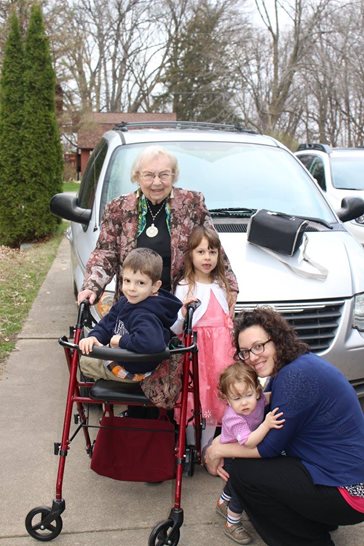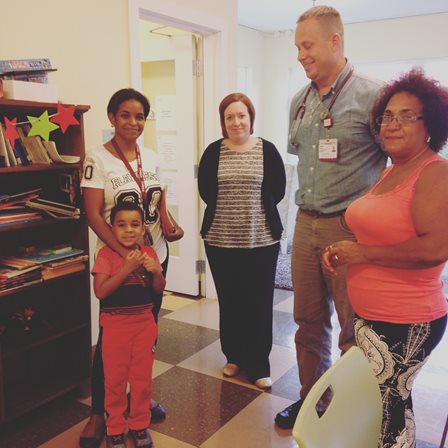My mother’s brush with death started out innocuously. She had a persistent “wheezing,” and while—as the days passed by and it turned into a cough—she knew it probably should have gone away by that time, it took too much energy to catch the required two buses to visit her physician. It could wait a little longer, she reasoned.

Yes, at 85, that was not the smartest conclusion, but she has always been the type to not complain. I live a two-hour flight away and my sister requires a two-hour drive to visit. She didn’t want to use up our calls and visits with what she viewed as “whining,” so we had no idea she was feeling so poorly. When my sister began to catch on, my mom promised to visit her doctor. But she didn’t. Already living alone in a retirement community, she stopped going downstairs for meals regularly or even visiting her friends. Meanwhile, the weariness caused by the cough caused her to stop doing the exercises she needed to rehabilitate her recently repaired shoulder.
Both of those disasters in the making could likely have been nipped in the bud if she had been able to “virtually” consult with a physician or nurse early on. Instead, she developed pneumonia and came very close to dying. She has never fully recovered; in fact, in a few weeks, she will have to move in with my sister, away from the retirement community she loves.
Such a scenario is exactly the type that Kim Farrar, vice president of residential services at Avesta Housing in Portland, Maine, hopes to prevent with the organization’s experiment with telemedicine.
NeighborWorks member Avesta houses more than 3,200 residents in more than 80 rental buildings. Half are seniors, and a substantial percentage are new immigrants to the country who are not yet in the routine of regular health care visits. The result is often either delayed care or expensive emergency room visits. Along the way to addressing this challenge, Farrar and Avesta learned a few lessons.
Lesson No. 1: Need comes first
The idea for the experiment came when Farrar learned that Avesta would be given extra points for inclusion of a telemedicine room in its application for funding of a 28-unit development for seniors. Virtually connecting residents to health care experts from the convenience of their homes seemed to offer clear advantage to everyone involved. Residents would have a greater chance of receiving the health care intervention they need and property owners and managers would have more stable tenants.However, Farrar admits, that this particular project started out a little "backwards."
"Start first with understanding what residents need and then find partners to work with you on that, not with an opportunity offered by a funder or what sounds cool," says Farrar.
Lesson No. 2: Partner early on
“The problem was that although we now had a telemedicine room, we had received no direction about how we should implement it,” recalls Farrar. So a member of the development team reached out to nearby York Hospital—and began what Farrar says has been a steep learning curve.
There are, Farrar learned, several ways to operate this kind of program. The room can be a satellite office/exam room, with a nurse seeing patients and consulting with the physician online. It also can be allocated for actual physician visits, with the computer used for online consultations with specialists. However, many residents already had their own physicians and didn’t want to switch to a York doctor. Thus, Avesta and York decided to proceed with an “urgent care center” model, in which the health care team doesn’t replace the residents’ own physicians, but acts instead as an immediate, on-site interim assessment/triage service.
Fortunately, York Hospital was simultaneously exploring how to offer such a program on a fee-for-service basis to area employers. It had been planning to test it out using its own employees, and was happy to include the 28 senior residents of Avesta’s Young Street Apartments. The pilot launched about a month ago, beginning with on-site training for residents both on how to use a computer and how to access the service.
This is how it works: Residents sign up online for a virtual visit in the telemedicine room, then link with the physician “on call.” Rashes, moles, etc. can be viewed by webcam and patients can take their own vital signs, such as temperature. Antibiotics can be prescribed, and advice given. No fee is charged, and when the pilot ends, the hospital has agreed to continue since the number of participants is small. However, Farrar points out, providing this kind of service to larger developments would likely have to be offered on some kind of sliding-scale fee basis.
“We haven’t been operational long enough to assess results,” says Farrar, “but so far the residents are telling us they love it.”
Lesson No. 3: Scale helps

Through the MaineHealth collaboration, launched in June, a visiting nurse service now serves four of Avesta’s rental properties. Funding comes from grants and other sources available for public health programming, with some services covered by insurance.
“There is not as much we can do at a small property like Young Street, or when the buildings are really spread out,” explains Farrar. “But when you have a concentrated, physical mass there is more you can accomplish.” Plus, more data can be collected, which will attract more support.
Once a month, the nurse visits four “hub” locations—two for seniors and two that are non-age-restricted. Visits are available both by appointment and as walk-ins. Again, the nurse cannot replace a resident’s personal physician, but he or she can listen to and assess complaints, check use of prescription medications, follow up on blood work, etc. In fact, in just a few months, the nurse already has identified one person who was very sick and hadn’t realized it.
“This is a six-month pilot, and we’ve found the most use of the service among seniors,” says Farrar. “It was a little more challenging to engage some of our new Americans, who have cultural and other barriers. So you need to experiment with different hours and ways of introducing it.”
At one of the hub locations, a telemedicine-equipped room is used for follow-ups with a nurse when one is not on site. MaineHealth has set up a call center, so a nurse is always available for check-ins. In the future, Farrar hopes individuals recently discharged from the hospital will be given Bluetooth-enabled thermometers, scale, blood pressure cuffs, etc. to take their own vital signs, with the results fed into a handheld tablet and transmitted to the hospital or physician.
“The main goal is to incorporate more of our residents into the benefits of such services,” Farrar says.

